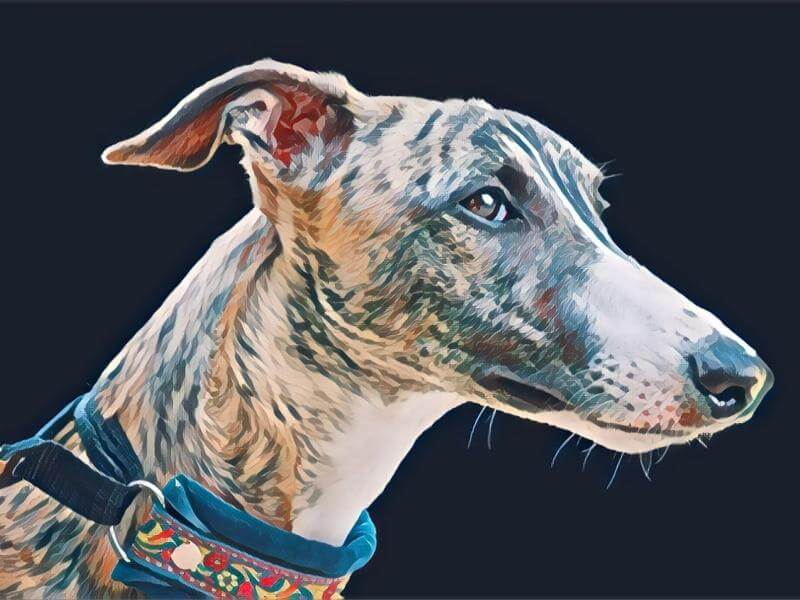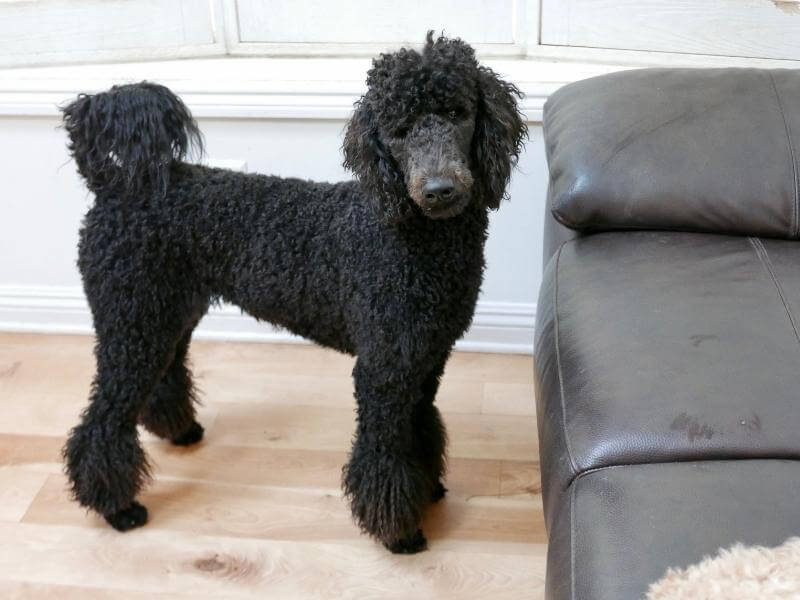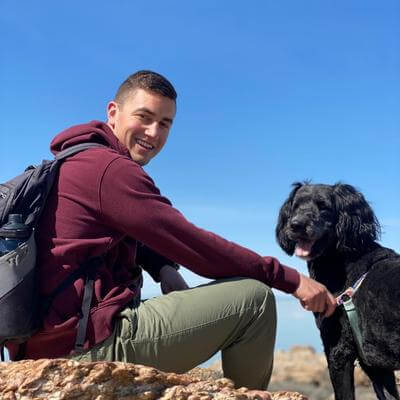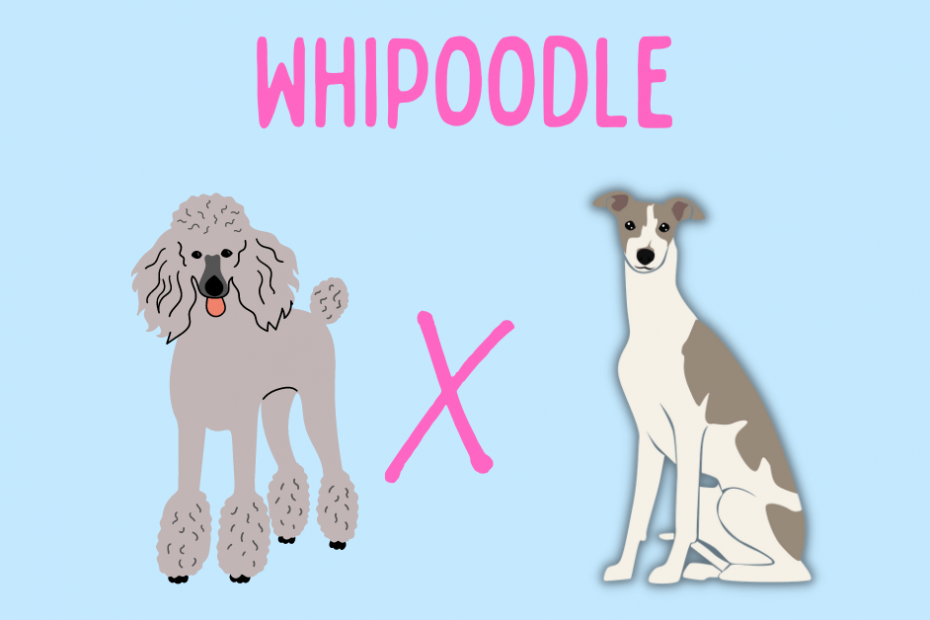The Whipoodle is a mix between a Poodle and a Whippet.
This medium-sized Doodle breed is a low-shedding cuddle bug. They are a perfect fit for any active family.
In this guide, I will cover everything about the Whipoodle to help you decide if this is the breed for you.
What is a Whipoodle?
A Whipoodle, in simple words, is a dog breed resulting from breeding a Whippet and a Poodle. They are also called Whipoos or Whipadoodles. Most Whipoodles are bred from standard Poodles, which makes them a medium to large-sized Doodle breed.
A Whippet is a medium size dog breed that originated in England. They are descendants of Greyhounds, which is why Whippets nowadays closely resemble small Greyhounds. However, unlike the Whippet, a Greyhound is more of a racing or hunting dog.
On the other hand, the standard Poodle is a medium-sized water dog. They are very intelligent and love to stay active with their owners.
It helps to learn more about the Whippet-Poodle mix by looking at the history of both parent breeds.
History of the Parent Breeds
Whipoodles are a new and unique Doodle breed. Like most modern-age designer dogs, they don’t have much of a documented history. Their origin may have happened on accident, or possibly a breeder decided to mix a Poodle with a Whippet deliberately.
We do know quite a lot about the parent breeds. Learning about their history gives us a better understanding of the traits and characteristics of the Whipoodle.
Whippets

For centuries, many small Sighthounds have been seen in oil paintings, either playing with other dogs or walking with a human. Every century has its own definition of the Whippets. But in the 19th century, Whippets were described as a cross between a Greyhound and a Spaniel.
Glancing at history, many dogs looked like Whippets hundreds of years ago. Solid evidence of Whippets goes back to the 17th century when they were eventually given the name.
In the mid-1800s, the pure breed concept first emerged, and in 1859, the first dog show was held, which gave birth to the American Kennel Club in 1884, and the most famous dog show that is now held every year.
After the 19th century, Whippets were recognized as a mix of terriers and small English Greyhounds. However, the initial appearance was not sleek. So, Italian Greyhounds were introduced for breeding, making the Whippets look better.
The history states that Whippets were brought to America by English mill operatives in Massachusetts.
In Victorian England, coal miners used to take their dogs for racing competitions and rabbit hunting expeditions in their off time. However, they couldn’t manage to provide enough space for their dogs, considering their size. So the idea of creating a smaller Greyhound breed came.
There is no detailed and documented evidence about which specific breed was behind the Whippet that resulted from the need to create a smaller dog. Nevertheless, as the coal miners shifted their work, the breed followed them and came to New England and America.
Another name for the Whippets is “Snap-Dogs” because of their speed in snapping up a nearby target. While these dogs became popular in the 19th century, they began their rise to popularity in the 18th century.
At first, these dogs were used to catching any prey in sight, and their speed and agility enabled them to catch prey relatively easily.

At the end of the 18th and the start of the 19th centuries, small Whippet-like dogs were typical among those who could not afford a Greyhound. As more and more people started showing an interest in Whippets, they were given a new title, “the poor man’s Greyhound.”
People used to take them for rabbit hunting, and later, rabbit skin was used to train the Whippets to improve their hunting skills. The rabbit skin was also used in lure coursing, and the racing Whippets gained nationwide popularity.
Whippets, once called the poor man’s Greyhound, started to attract even the richest, who then started participating in such races. In 1899, Whippets were the official breed of the American Kennel Club.
In the 1970s, lure coursing sessions were held for Whippets to enjoy running and hunting, where they’d chase a plastic bag instead of a rabbit. Whippets have historically been great dogs for watchkeeping.
They don’t bark unprovoked as much as other dogs, so having them around won’t disturb anyone. While cheerful and playful, they might hesitate to meet a new person. So, avoid directly petting them. Instead, gently approach them and see their reaction.
Poodle

The Poodle originated in Germany sometime around the 17th century. The German name of this breed is “pudel” or “pudelin,” meaning “to splash in the water.” This is fitting because they were bred to be water dogs.
Hunters used these dogs to retrieve game from the water. Their iconic continental clip is not just for looks. It was used to keep their bodies warm while they plunged into the cold waters of European rivers and lakes to retrieve game.
The standard Poodle became popular all across Europe. They were even used as circus performers in some regions. Their intelligence, good looks, and overall demeanor made them the favorite of the French nobles. Eventually, France adopted the Poodle as their national dog.
The standard Poodle was bred down in size to create the Miniature Poodle. After Poodles were introduced to America, they were bred down even further to make the Toy Poodle.
Poodles of all sizes are a popular dog breed today. If you want to learn more about this beautiful breed, check out my in-depth guide to standard Poodles.
Appearance
A Whipoodle features a long, sleek body with lots of fur. On average, this dog is moderately sized but can often get noticeably large or small, depending on different factors. Ultimately, their parents will have the most profound effect on their appearance.
This will depend on which breed was used as the father or mother.
A Whippet looks like a Greyhound with long and slender legs. In fact, at first sight, people often mistake it for a Greyhound, but Whippets are relatively peaceful and friendly.
Their entire bodies are lean and muscular, with an abdomen neatly tucked up. They have a fairly long tail but usually keep it low and have big, lustrous eyes.
Unlike Whippets, Poodles have lots of hair across their bodies. Among other peculiar features are a square outline, a straight back, and an elegant long neck. Like many other dogs, they have floppy ears.
Coat Type
Whipoodles have either wavy or curly coats, just like Poodles; they don’t have short hair like Whippets. They shed little to no hair, which is why they are popular with people allergic to animal hair.
Whippets have short, smooth coats, so they don’t need to be brushed or bathed frequently. You can groom or wash them once a week to keep them clean. However, make sure not to wear a coat or jacket when petting them, as they shed hair quickly, and getting that out of certain clothes can be a hassle.
Poodles have curled hair and a single dense coat. The hair grows and falls like normal, but it doesn’t shed much like a Whippet or other dog. Moreover, they don’t shed hair seasonally; instead, they lightly lose hair throughout the year.
The Poodle’s hypoallergenic coat makes them attractive dogs to mix with.
Coat Colors
A Whipoodle’s coat color highly depends on the parents’ colors or the recessive genes. Most Whipoodles have black, brown, and white spots on their faces, but some can have other colors on their paws, faces, and chest.
Whipoodle coats have two to three coat colors; you can only determine a puppy’s color by looking at its parents’ coat colors.
Based on the standard colors of the Whippet and the Poodle, below are the possible coat colors your Whipoodle may have:
- Black
- Gray
- Fawn
- Tan
- Orange
- Silver
- Gray
- Cafe au Lait
- Cream
- White
- Parti Poodles
- Brown
- Silver Beige
Coat Patterns
The Whippet-Poodle mix inherits a few possible coat patterns. The pattern will depend on the parent’s genes.
Below are a few coat patterns that a Whipoodle may exhibit:
- Merle
- Blue Merle
- Red Merle
- Chocolate Merle
- Brindle
- Tuxedo
- Phantom
- Parti-color
- Monocolor
- Tricolor
- Abstract
Height
The height of a Whipoodle should be around 15-22 inches.
While Whipoodles get their hair from Poodles, they inherit their height from Whippets. Whippets can grow up to 18-22 inches, while a Poodle has a standard size of 15+ inches.
The average height of a female Whippet is 18-21 inches, while a male Whippet stands at around 19-22 inches [1]akc.org/dog-breeds/whippet.
Weight
Based on the parents’ weight, a fully-grown male Whipoodle can weigh as much as 70 pounds. At the same time, the max female weight is around 50 pounds. On the lower range, a Whipoodle can weigh between 20-30 pounds.
The average weight range for Whippets is 25-40 pounds [2]akc.org/dog-breeds/whippet.
Compared to the Whippet, Poodles can get twice as heavy. A full-grown male Poodle can weigh around 70 pounds, and an average female weighs about 40-50 pounds [3]akc.org/dog-breeds/poodle-standard.
Traits and Characteristics

Personality of the Whipoodle
Whippets and Poodles get along with other dogs reasonably quickly. Many owners use Whippets to help exercise their other dogs. Moreover, these dogs are an excellent option for playing with your kids as they love running around.
Get a ball, give it to your kid, and watch how these dogs can keep your child engaged.
Whipoodles are smart, calm, playful, and obedient. However, it also needs moderate exercise and running to avoid negative behaviors. They are not skilled hunters like their parents, but they would love to chase anything small to stay entertained.
It is the most in-demand breed because of its friendly and fun traits. They won’t attack other animals, no matter how small or big they are. If you have cats at home and your cats are calm, a Whipoodle can be friendly with them and even play with them. It might chase the cat, but it’s not likely to attack even if the cat is toying with it.
They love to sprint with other dogs and chase the ball while other dogs also chase it. Due to their strong prey drive, they might start chasing other small animals in the park, so be careful.
A Whipoodle puppy might be a bit hard to handle, but after some months, Whipoodle will be friendly with anyone visiting your home.
Whipoodles are full of energy and require a walk of roughly 20 minutes daily. Once they walk, run, or exercise, they’ll spend the rest of the day chilling at home. On the other hand, they are easy to train, but not in the first three to four months.
They’ll start listening to their owners more and more as they grow up. After a year, they will be trained to listen to practically everything you say.
Common Health Issues
The Whipoodle inherits most health problems from Poodles, like bloating, thyroid issues, Addison’s Disease, and hip dysplasia. Some health issues are inherited from the Whippet parent too.
That said, here are some health issues that you should be aware of in your Whippet-Poodle mix:
- Eye problems
- Progressive Retinal Atrophy
- Mitral valve disease
- Immune-mediated problems
- Addison’s Disease
- Thyroid Issues
- Hip Dysplasia
- Collapsed Trachea
Lifespan
The average lifespan of a Whipoodle is 12-15 years.
Training
Whippets and Poodles are both reasonably easy to train. Therefore, the Whipoodle should respond well to obedience training.
It is recommended to start training early on in puppyhood. The first year might be challenging as the dog has to adapt to its surroundings. Make sure to give them enough time daily so they start bonding with you. Also, bring them toys so they won’t chew on your shoes or furniture.
Have some spare space to run around and be ready as they climb everything they see. They won’t run the whole day, however. Regular exercise will help keep your pup’s energy levels at bay.
Once adequately trained, Whipoodles would have no problem living with other animals, especially a cat, unless your other pet decides to start running or attacking the dog. They tend to chase many small animals, which is not a problem as Whipoodles see small animals as their friends and not prey.
Another good trait of Whipoodles is that they are not very vocal and bark only to alert or answer the doorbell.
Grooming
Despite one of their parents (Whippets) not requiring extra grooming, Whipoodles require grooming like Poodles because of their shaggy coats. That doesn’t mean you must groom them daily, but two or three times a week would be enough.
Whipoodles don’t shed their hair. While brushing them once or twice a week is fine, you need to get their hair trimmed every 8 to 16 weeks, depending on your Whipoodle’s coat. If you decide to keep their hair short, these dogs might require grooming every week, which is costly.
So, it’s better to grab a grooming kit if you wish to keep your dog’s fur the way you want and learn to groom your dog properly.
Don’t worry about mistakes; their hair grows quickly, so they’ll be back in furry shape within two or three weeks. However, be careful while grooming, as Whipoodles are pretty sensitive.
Final Thoughts
The Whipoodle is an exciting new Doodle dog breed. In this article I covered everything about the Whippet-Poodle mix:
- What is a Whipoodle?
- History of the parent breeds
- Whipoodle Appearance
- Traits, Characteristics, and Personality of the Whipoodle
- Whipoodle Health Issues
- Grooming
- Training
If you want to learn about other Poodle-mixes, check out my mega post on Doodle breeds.

References

